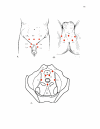Pelvic tenderness is not limited to the prostate in chronic prostatitis/chronic pelvic pain syndrome (CPPS) type IIIA and IIIB: comparison of men with and without CP/CPPS
- PMID: 17908331
- PMCID: PMC2072943
- DOI: 10.1186/1471-2490-7-17
Pelvic tenderness is not limited to the prostate in chronic prostatitis/chronic pelvic pain syndrome (CPPS) type IIIA and IIIB: comparison of men with and without CP/CPPS
Abstract
Background: We wished to determine if there were differences in pelvic and non-pelvic tenderness between men with chronic prostatitis/chronic pelvic pain syndrome (CP/CPPS) Type III and men without pelvic pain.
Methods: We performed the Manual Tender Point Survey (MTPS) as described by the American College of Rheumatology on 62 men with CP/CPPS Type IIIA and IIIB and 98 men without pelvic pain. We also assessed tenderness of 10 external pelvic tender points (EPTP) and of 7 internal pelvic tender points (IPTP). All study participants completed the National Institutes of Health Chronic Prostatitis Symptom Inventory (NIH CPSI).
Results: We found that men with CPPS were significantly more tender in the MTPS, the EPTPS and the IPTPS. CPSI scores correlated with EPTP scale but not with IPTP scale or prostate tenderness. Prostatic tenderness was present in 75% of men with CPPS and in 50% of men without CPPS. Expressed prostatic fluid leukocytosis was not associated with prostatic tenderness.
Conclusion: Men with CP/CPPS have more tenderness compared to men without CPPS. Tenderness in men with CPPS is distributed throughout the pelvis and not specific to the prostate.
Figures

Similar articles
-
Two-year experience with the german-translated version of the NIH-CPSI in patients with CP/CPPS.Urology. 2004 Jun;63(6):1027-30. doi: 10.1016/j.urology.2004.02.002. Urology. 2004. PMID: 15183940
-
A novel and simple approach to distinguish chronic prostatitis/ chronic pelvic pain syndrome IIIb from IIIa using virtual touch tissue quantification.Bosn J Basic Med Sci. 2011 Nov;11(4):205-8. doi: 10.17305/bjbms.2011.2546. Bosn J Basic Med Sci. 2011. PMID: 22117824 Free PMC article.
-
Electroacupuncture relieves pain in men with chronic prostatitis/chronic pelvic pain syndrome: three-arm randomized trial.Urology. 2009 May;73(5):1036-41. doi: 10.1016/j.urology.2008.10.047. Urology. 2009. PMID: 19394499 Clinical Trial.
-
Contemporary Management of Chronic Prostatitis/Chronic Pelvic Pain Syndrome.Eur Urol. 2016 Feb;69(2):286-97. doi: 10.1016/j.eururo.2015.08.061. Epub 2015 Sep 26. Eur Urol. 2016. PMID: 26411805 Review.
-
Chronic prostatitis/chronic pelvic pain syndrome in elderly men: toward better understanding and treatment.Drugs Aging. 2003;20(15):1111-25. doi: 10.2165/00002512-200320150-00004. Drugs Aging. 2003. PMID: 14651434 Review.
Cited by
-
Chronic Pelvic Pain: Assessment, Evaluation, and Objectivation.Pain Res Treat. 2017;2017:9472925. doi: 10.1155/2017/9472925. Epub 2017 Nov 20. Pain Res Treat. 2017. PMID: 29359045 Free PMC article. Review.
-
Etiology of chronic prostatitis/chronic pelvic pain syndrome: psychoimmunoneurendocrine dysfunction (PINE syndrome) or just a really bad infection?World J Urol. 2013 Aug;31(4):725-32. doi: 10.1007/s00345-013-1061-z. Epub 2013 Apr 12. World J Urol. 2013. PMID: 23579440 Review.
-
Evidence for overlap between urological and nonurological unexplained clinical conditions.J Urol. 2013 Jan;189(1 Suppl):S66-74. doi: 10.1016/j.juro.2012.11.019. J Urol. 2013. PMID: 23234637 Free PMC article. Review.
-
Implications of the Genitourinary Microbiota in Prostatic Disease.Curr Urol Rep. 2019 May 18;20(7):34. doi: 10.1007/s11934-019-0904-6. Curr Urol Rep. 2019. PMID: 31104156 Review.
-
Evidence for overlap between urological and nonurological unexplained clinical conditions.J Urol. 2009 Nov;182(5):2123-31. doi: 10.1016/j.juro.2009.07.036. Epub 2009 Sep 16. J Urol. 2009. PMID: 19758633 Free PMC article. Review.
References
-
- Schaeffer AJ, Landis JR, Knauss JS, Propert KJ, Alexander RB, Litwin MS, Nickel JC, O'Leary MP, Nadler RB, Pontari MA, Shoskes DA, Zeitlin SI, Fowler JE, Jr, Mazurick CA, Kishel L, Kusek JW, Nyberg LM. Leukocyte and bacterial counts do not correlate with severity of symptomsin men with chronic prostatitis: the National Institutes of Health ChronicProstatitis Cohort Study. J Urol. 2002;168:1048–1053. doi: 10.1016/S0022-5347(05)64572-7. - DOI - PubMed
-
- Schaeffer AJ, Landis JR, Knauss JS, Propert KJ, Alexander RB, Litwin MS, Nickel JC, O'Leary MP, Nadler RB, Pontari MA, Shoskes DA, Zeitlin SI, Fowler JE, Jr, Mazurick CA, Kishel L, Kusek JW, Nyberg LM. Demographic and clinical characteristics of men with chronic prostatitis: thenational institutes of health chronic prostatitis cohort study. J Urol. 2002;168:593–598. doi: 10.1016/S0022-5347(05)64686-1. - DOI - PubMed
Publication types
MeSH terms
LinkOut - more resources
Full Text Sources
Medical
Miscellaneous

